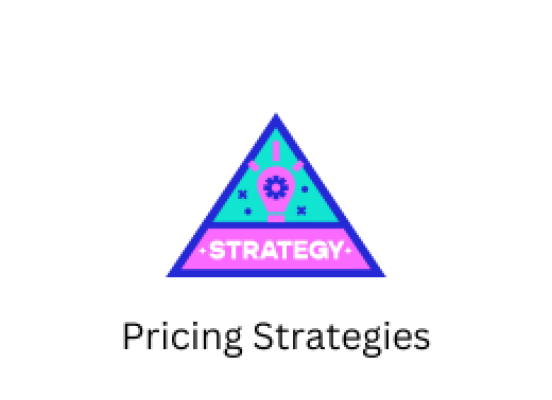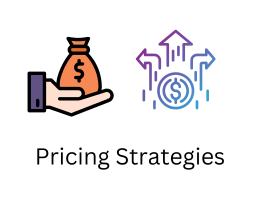
Pricing Strategies: Explore various pricing models, including dynamic pricing, value-based pricing, and psychological pricing, to determine the optimal price points for your products or services.
- By admin --
- Wednesday, 08 Nov, 2023
Introduction
Pricing is a critical element in the marketing mix, and it has a profound impact on a business's profitability and competitiveness. Companies often find themselves at a crossroads when determining the right pricing strategy for their products or services. There's no one-size-fits-all solution, as pricing should align with a company's objectives, market conditions, and customer expectations. In this article, we'll explore various pricing models, including dynamic pricing, value-based pricing, and psychological pricing, to help businesses determine the optimal price points for their offerings.
- Dynamic Pricing
Dynamic pricing, also known as demand-based pricing or surge pricing, involves adjusting prices in real-time based on various factors, such as demand, competitor prices, and inventory levels. This approach is commonly used in industries like travel, hospitality, and e-commerce. The goal of dynamic pricing is to maximize revenue by setting prices at the highest level that customers are willing to pay at any given moment.
Key Considerations:
- Real-time data analysis: Dynamic pricing relies on continuous monitoring and analysis of market conditions and customer behavior. Businesses need robust data analytics tools to implement this strategy effectively.
- Competitive intelligence: Understanding competitor pricing and market dynamics is essential to make timely price adjustments.
- Price elasticity: Assessing how responsive customer demand is to price changes helps in setting optimal price points.
Benefits of Dynamic Pricing:
- Maximizes revenue during peak demand periods.
- Helps clear excess inventory.
- Adapts to changing market conditions and competitor pricing.
- Enhances revenue and profit margins.
Challenges of Dynamic Pricing:
- Customer perception: Frequent price changes can lead to customer mistrust and backlash.
- Regulatory concerns: Some industries face regulatory scrutiny for dynamic pricing practices.
- Technical requirements: Implementing and maintaining dynamic pricing systems can be complex and costly.
- Value-Based Pricing
Value-based pricing centers on the idea that the price of a product or service should reflect the perceived value it provides to customers. Rather than focusing solely on production costs, value-based pricing considers what customers are willing to pay based on the benefits, features, and overall value they receive. This strategy is particularly effective when selling differentiated or premium products and services.
Key Considerations:
- Customer segmentation: Different customer segments may attribute different values to the same product, so tailoring pricing to each segment is essential.
- Market research: Conduct market research to understand customer perceptions of value and how they evaluate products or services.
- Positioning and branding: Effective branding and positioning are crucial in justifying higher prices based on perceived value.
Benefits of Value-Based Pricing:
- Captures the maximum value from customers willing to pay a premium for superior products or services.
- Encourages innovation and product differentiation.
- Enhances brand image and customer loyalty.
Challenges of Value-Based Pricing:
- Market competition: Competitors offering similar value propositions can limit the pricing flexibility.
- Customer education: Convincing customers of the value provided may require additional marketing and education efforts.
- Consistently delivering the promised value is essential to maintain trust.
- Psychological Pricing
Psychological pricing leverages human psychology and perception to influence buying decisions. This strategy involves setting prices that create a specific psychological effect, such as making the product appear more affordable or exclusive. Common tactics include setting prices just below round numbers (e.g., $9.99 instead of $10) or highlighting discounts and savings.
Key Considerations:
- Perception and emotions: Understanding how customers perceive prices and the emotions associated with them is crucial for this strategy.
- Testing and experimentation: Businesses often engage in A/B testing to assess the impact of different psychological pricing techniques on customer behavior.
- Anchoring: Using a higher initial price (anchor) to make the final price seem like a bargain is a common psychological pricing technique.
Benefits of Psychological Pricing:
- Encourages impulse buying and perceived value.
- Creates a perception of affordability and savings.
- Enhances pricing strategies in retail and e-commerce.
Challenges of Psychological Pricing:
- May not be suitable for all products or services, especially those requiring a straightforward, no-frills approach.
- The risk of eroding brand integrity if used excessively or inappropriately.
- Requires ongoing monitoring and adjustment based on customer responses.
Conclusion
Pricing is a multifaceted aspect of business strategy that can significantly impact a company's success. While the three pricing strategies discussed—dynamic pricing, value-based pricing, and psychological pricing—offer distinct approaches, the optimal pricing strategy for a business depends on its specific goals, market conditions, and target customers.
Dynamic pricing, with its real-time adjustments, is well-suited for industries where demand fluctuates significantly, but it can be complex to implement. Value-based pricing, on the other hand, focuses on aligning prices with the perceived value of the product or service, which can be effective for premium offerings. Psychological pricing, leveraging human psychology, is a valuable tool to influence customer perceptions and purchasing decisions.
In practice, businesses often employ a combination of these strategies to maximize revenue and profitability. Moreover, flexibility and the ability to adapt to changing market conditions are essential, as what works best today may need adjustments in the future. By carefully considering these pricing strategies and their nuances, businesses can make informed decisions to optimize their pricing and drive success in their respective markets.





